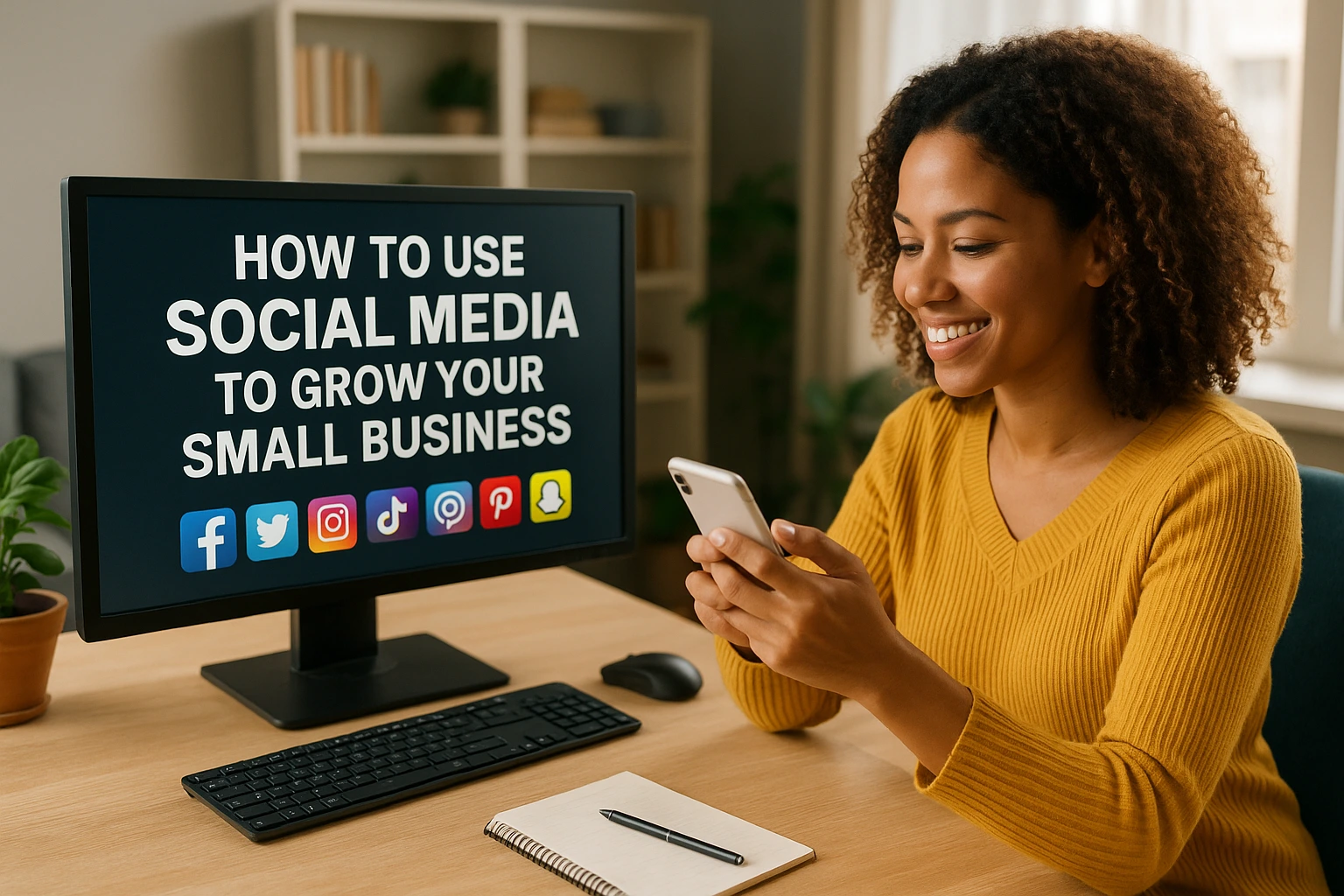Social media isn’t just a place to scroll through memes and cat videos. For small business owners, it’s one of the most powerful (and affordable) tools to build brand awareness, connect with customers, and drive real sales.
The problem? Most small entrepreneurs don’t know how to use social media strategically. They either post randomly, try to be everywhere at once, or feel overwhelmed by algorithms and trends.
In this complete guide, you’ll learn how to use social media the right way — with purpose, consistency, and results.
Why Social Media Matters for Small Businesses
You might wonder, “Does my small business really need social media?” The short answer: Yes.
Here’s why:
- It’s free or low-cost: You can get started without paying for ads.
- It builds relationships: Social media is where conversations happen — and relationships turn into customers.
- It creates trust: When people can see your work, read reviews, and engage with you, they feel more confident buying from you.
- It drives traffic: Posts, stories, and videos can lead people to your website, shop, or booking page.
- It keeps you top of mind: People may not buy right away, but consistent content reminds them you exist.
Whether you sell physical products, offer services, or run a local shop, social media helps you reach more of the right people — fast.
Step 1: Choose the Right Platforms for Your Business
You don’t need to be on every platform. Focus on 1–2 where your audience already spends time.
Here’s a quick overview of the major platforms:
Great for: Visual businesses (food, fashion, design, beauty), lifestyle brands, creatives
Best features: Reels, stories, product tags, DMs, hashtags
Tips: Use high-quality visuals, behind-the-scenes content, and trending audio
Great for: Local businesses, service providers, older audiences (30+), community-building
Best features: Business pages, groups, events, reviews, marketplace
Tips: Share blog links, create groups, run targeted local ads
TikTok
Great for: Trendy, creative brands targeting Gen Z and millennials
Best features: Short-form video, viral reach, trending sounds
Tips: Keep videos casual, add value fast, join trends early
Great for: B2B companies, consultants, coaches, professional services
Best features: Articles, thought leadership posts, professional networking
Tips: Share your expertise, client wins, and personal business journey
Great for: Products, DIY, fashion, food, decor, blogging
Best features: Visual search engine, pin boards, links to website
Tips: Pin consistently, use keywords, link back to your site or shop
Know where your customers are — and meet them there.
Step 2: Define Your Social Media Goals
Posting without a goal is like driving without a destination. Define what success looks like for your business.
Common social media goals:
- Grow brand awareness
- Drive traffic to your website or shop
- Get new leads or inquiries
- Sell products or book services
- Build community or trust
Choose 1–2 goals to focus on for the next 3 months. This keeps your content aligned and your results measurable.
Step 3: Create a Content Plan That Serves and Sells
The best social media content does two things:
- Serves your audience — teaches, inspires, or entertains them
- Promotes your offer — clearly shows how they can buy or work with you
Use the 80/20 rule: 80% valuable content, 20% promotional.
Types of content to post:
- Educational: Tips, tutorials, FAQs, myth-busting, how-tos
- Inspirational: Client wins, testimonials, behind-the-scenes, your story
- Entertaining: Reels, memes, relatable moments in your niche
- Promotional: Product features, limited-time offers, launches, case studies
Write content in a tone that matches your brand — whether it’s friendly, professional, fun, or bold.
Pro tip: Batch-create content once a week. It saves time and keeps you consistent.

Step 4: Use Hashtags and Keywords Strategically
Hashtags and keywords help your content get discovered by new people.
Hashtag tips:
- Use 5–15 hashtags per post on Instagram
- Mix large, medium, and niche hashtags
- Avoid banned or overused tags
- Create a branded hashtag for your business
Keyword tips:
- Use keywords in your captions and bio
- On Pinterest, write keyword-rich pin descriptions
- On TikTok and YouTube, say your keywords out loud in the video
Hashtags = exposure. Keywords = searchability. Use both.
Step 5: Engage Consistently (Don’t Just Post and Ghost)
Social media is not a megaphone — it’s a conversation. Engaging with your audience builds trust, loyalty, and visibility.
How to engage:
- Reply to every comment and DM
- Like and comment on your followers’ content
- Thank people who share your posts
- Ask questions to spark conversation
- Use polls and stickers in stories to increase interaction
The algorithm favors active accounts. The more you engage, the more people see your content.
Step 6: Show Your Face (Even If You’re Shy)
People don’t just buy from businesses — they buy from people they trust.
Showing your face occasionally:
- Builds personal connection
- Increases engagement (face = more views)
- Humanizes your brand
You don’t have to dance or share your life story. Just hop on stories, say hi, share tips, or talk about what you’re working on.
Video builds connection faster than any caption ever could.
Step 7: Use Stories, Reels, and Lives to Expand Reach
Static posts are just the beginning. To grow fast, use video and interactive content.
Stories (Instagram, Facebook)
- Great for daily updates, offers, or behind-the-scenes
- Add polls, quizzes, countdowns, and links
- Disappear in 24 hours — feel casual, not polished
Reels (Instagram, Facebook)
- Short, vertical videos — huge potential for reach
- Focus on quick tips, trends, product demos, or relatable content
- Use trending sounds and keep text on screen
Lives
- Powerful for launches, Q&As, or tutorials
- Real-time interaction builds trust
- You can save the replay as a post
Don’t overthink it. Start simple and build confidence.
Step 8: Track What Works — And Do More of It
Social media success isn’t random. It’s a result of testing, learning, and improving over time.
Track:
- Follower growth
- Engagement (likes, comments, shares, saves)
- Reach and impressions
- Clicks or conversions (website visits, inquiries, sales)
- Which posts perform best
Check insights weekly or monthly. Look for patterns. Then create more of what your audience loves.
Step 9: Use Tools to Save Time and Stay Consistent
Managing social media as a busy entrepreneur can be overwhelming. That’s where tools help.
Scheduling tools:
- Buffer
- Later
- Planoly
- Meta Business Suite (for Facebook & Instagram)
Design tools:
- Canva (templates for posts, stories, reels, and more)
Link tools:
- Linktree or Beacons to create a bio link with multiple destinations
Batch your content, schedule ahead, and show up daily — even when you’re busy.
Step 10: Don’t Obsess Over Vanity Metrics
It’s easy to chase likes, views, or followers. But those numbers don’t always mean more sales.
Instead, focus on:
- How many people visit your website
- Who’s signing up for your email list
- Who’s sending you DMs or referrals
- Who’s buying, booking, or engaging meaningfully
Small audiences can still bring big results. Impact > popularity.
Final Thoughts: Grow With Intention, Not Just Attention
You don’t need to go viral or be an influencer to grow your small business on social media. What you need is:
- A clear strategy
- Consistent value
- Real engagement
- A human touch
Start simple. Show up daily. Focus on helping your audience — and invite them to take the next step with you.
Social media success doesn’t happen overnight. But with focus and consistency, you’ll build trust, grow your brand, and attract the right customers — one post at a time.

